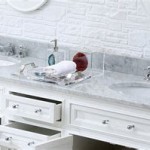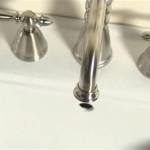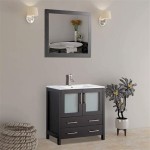Can You Paint A Bathroom Sink Cabinet? A Comprehensive Guide
Painting a bathroom sink cabinet is a viable and cost-effective method to refresh the look of a bathroom without undertaking a full renovation. A fresh coat of paint can revitalize an outdated or worn cabinet, aligning it with current design trends or simply providing a cleaner, more appealing aesthetic. However, a successful painting project requires careful planning, meticulous preparation, and the use of appropriate materials. This article will explore the necessary steps and considerations involved in painting a bathroom sink cabinet, outlining the best practices for achieving a durable and aesthetically pleasing finish.
The bathroom environment presents unique challenges compared to other areas of the home. High humidity levels and frequent exposure to water can damage paint and compromise the integrity of the cabinet over time. Therefore, selecting the appropriate type of paint and employing proper application techniques are crucial for a long-lasting result. This guide will cover the selection of suitable paints, primers, and tools, as well as detailed instructions for each stage of the painting process, from initial preparation to final coat application.
Key Point 1: Preparation is Paramount
The success of any painting project largely depends on the thoroughness of the preparation phase. Proper preparation ensures the paint adheres correctly to the surface, resulting in a smooth, even finish that resists chipping and peeling. Neglecting this crucial step can lead to premature failure of the paint job, requiring additional work and expense in the long run.
First, the cabinet must be thoroughly cleaned to remove any dirt, grease, soap scum, or other contaminants that may impede adhesion. A mild detergent solution is generally sufficient for this purpose. Scrub the surfaces with a non-abrasive sponge or cloth, paying particular attention to areas around the sink and faucet where grime tends to accumulate. Rinse thoroughly with clean water and allow the cabinet to dry completely before proceeding.
Next, inspect the cabinet for any existing damage, such as chips, cracks, or peeling paint. These imperfections must be addressed before painting to ensure a smooth and uniform surface. Use a wood filler or patching compound to fill any holes or cracks, following the manufacturer's instructions for drying time and application. Once the filler is dry, sand the repaired areas smooth with fine-grit sandpaper, blending them seamlessly with the surrounding surface.
Sanding the entire cabinet surface is an essential step in preparing for painting, even if there is no visible damage. Sanding creates a slightly roughened surface that provides a better grip for the primer and paint. Use a medium-grit sandpaper (around 120-150 grit) to lightly sand the entire cabinet, focusing on areas that are particularly smooth or glossy. After sanding, wipe the cabinet down with a tack cloth to remove any sanding dust. This ensures a clean surface free of debris that could compromise the paint finish.
Remove all hardware, such as knobs, pulls, and hinges, from the cabinet before painting. This prevents paint from getting on the hardware and allows for a more even and professional finish. If the hardware is being replaced, this step is straightforward. If the existing hardware is being reused, store it in a safe place to avoid losing any pieces. For a more streamlined process, consider labeling each piece of hardware and its corresponding location on the cabinet to simplify reassembly. If the hinges are integrated or difficult to remove, carefully mask them off with painter’s tape.
Finally, protect the surrounding areas from paint splatters and drips by covering the floor with drop cloths and masking off the walls and countertops with painter's tape. Applying painter's tape carefully and precisely is crucial for achieving clean, crisp paint lines. Ensure the tape is firmly adhered to the surface to prevent paint bleed-through. Consider using a plastic sheeting or tarp for added protection, especially if you are using a paint sprayer.
Key Point 2: Selecting the Right Paint and Primer
The choice of paint and primer is critical for achieving a durable and aesthetically pleasing finish on a bathroom sink cabinet. The bathroom environment demands paints that are resistant to moisture, mildew, and frequent cleaning. Selecting the correct products will significantly impact the longevity of the painted cabinet and its ability to withstand the rigors of daily use.
Primer serves as a crucial foundation for the paint, promoting adhesion, blocking stains, and creating a uniform surface. For bathroom cabinets, an oil-based or a high-quality stain-blocking primer is generally recommended. Oil-based primers offer excellent adhesion and stain-blocking properties, making them suitable for cabinets that have previously been painted with oil-based paints or are prone to staining. Stain-blocking primers are particularly useful if the cabinet is made of wood that is susceptible to discoloration from water or tannins.
Water-based primers are also an option, but it is important to select a high-quality product specifically formulated for use in humid environments. Latex primers are generally easier to clean up and have lower VOC (volatile organic compound) content compared to oil-based primers. However, they may not provide the same level of stain-blocking or adhesion on certain surfaces.
When choosing paint for a bathroom sink cabinet, consider factors such as durability, moisture resistance, and ease of cleaning. Semi-gloss and gloss finishes are generally preferred for bathrooms because they are more resistant to moisture and easier to wipe clean than matte or eggshell finishes. The higher sheen levels also reflect more light, which can brighten up a small bathroom space.
Latex-based paints are a popular choice for bathroom cabinets due to their durability, ease of application, and low VOC content. Look for paints that are specifically formulated for use in bathrooms or kitchens, as these products typically contain mildewcides that inhibit the growth of mold and mildew. Acrylic paints are another excellent option, offering superior adhesion and durability compared to standard latex paints. Alkyd paints, which are oil-based, provide a hard, durable finish that is highly resistant to moisture and stains. However, alkyd paints have a higher VOC content and require mineral spirits for cleanup.
In addition to selecting the appropriate type of paint and primer, consider the color and finish carefully. Choose colors that complement the overall bathroom décor and create the desired mood. Test paint samples in the bathroom under different lighting conditions to ensure the color appears as expected. Consider the durability of the chosen finish, as darker colors and higher sheen levels may show imperfections and scratches more readily.
Key Point 3: Painting Techniques for a Professional Finish
Proper painting techniques are essential for achieving a smooth, even, and durable finish on a bathroom sink cabinet. The method of application, whether it be brushing, rolling, or spraying, can significantly impact the final result. Combining the correct tools with a methodical approach will yield a professional-looking finish.
Before beginning the painting process, ensure that the primer is dry to the touch. Follow the manufacturer's recommended drying time, which may vary depending on the type of primer and the ambient humidity. Sand the primed surface lightly with fine-grit sandpaper (around 220-grit) to remove any imperfections or raised areas. Wipe the cabinet down with a tack cloth to remove any sanding dust.
When applying paint with a brush, choose a high-quality brush with synthetic bristles for latex paints and natural bristles for oil-based paints. Dip the brush into the paint, being careful not to overload it. Tap off any excess paint against the side of the can to prevent drips. Apply the paint in thin, even strokes, working in the direction of the wood grain. Avoid applying too much pressure, which can cause brush marks. Overlap each stroke slightly to ensure complete coverage.
For larger, flat surfaces, a roller can be used to apply paint more quickly and efficiently. Choose a roller with a nap size appropriate for the paint and the surface texture. A shorter nap roller is generally recommended for smooth surfaces, while a longer nap roller is better suited for textured surfaces. Load the roller with paint evenly by rolling it back and forth in a paint tray. Apply the paint in a smooth, consistent motion, overlapping each roll slightly. Avoid pressing too hard on the roller, which can cause the paint to splatter.
A paint sprayer can provide the smoothest and most even finish, especially on cabinets with intricate details or hard-to-reach areas. However, using a paint sprayer requires practice and careful preparation. Thin the paint according to the manufacturer's instructions to ensure proper atomization. Set up a well-ventilated spray area and protect the surrounding surfaces with drop cloths and masking tape. Hold the sprayer at a consistent distance from the cabinet and apply the paint in thin, overlapping coats. Avoid spraying too much paint in one area, which can cause runs and drips.
Allow each coat of paint to dry completely before applying the next coat. Follow the manufacturer's recommended drying time, which may vary depending on the type of paint and the ambient humidity. Lightly sand the surface between coats with fine-grit sandpaper to remove any imperfections or raised areas. Wipe the cabinet down with a tack cloth to remove any sanding dust. Apply at least two coats of paint for optimal coverage and durability. For darker colors or cabinets that have previously been painted with a different color, additional coats may be necessary.
Once the final coat of paint is dry, carefully remove the painter's tape. Pull the tape away from the painted surface at a 45-degree angle to prevent chipping. Reinstall the hardware that was removed earlier, ensuring that it is securely fastened. Clean up any paint splatters or drips with a damp cloth. Allow the paint to cure completely before using the cabinet, which may take several days or even a week depending on the type of paint. Avoid exposing the painted surface to excessive moisture or harsh cleaning agents during the curing process.
.jpg?strip=all)
Painting A Bathroom Vanity Again Dream Green Diy
.jpg?strip=all)
Painting A Bathroom Vanity Again Dream Green Diy

How To Paint Bathroom Cabinets Without Sanding 8 Vital Steps Grace In My Space

How To Quickly Paint A Bathroom Vanity Cabinet Entri Ways

Paint Bathroom Vanity Countertop Sink So Easy A Piece Of Rainbow

How To Paint A Bathroom Vanity Helpful Tips Calypso In The Country

How To Paint Laminate Cabinets Love Renovations

How To Paint Bathroom Vanity Cabinets Tutorial Benjamin Moore

How To Paint A Bathroom Vanity Angela Marie Made

How To Paint Melamine Cabinets A Small Bathroom Makeover Diy Soheila
Related Posts







